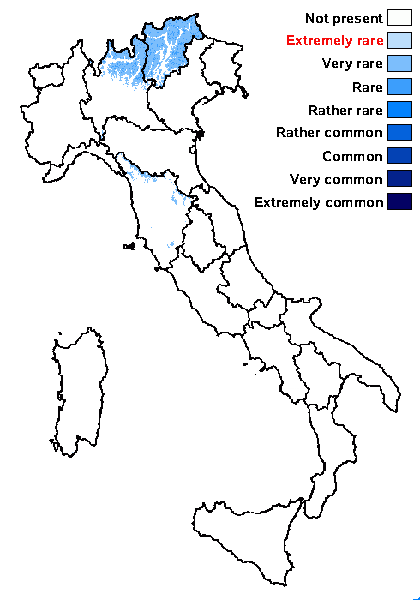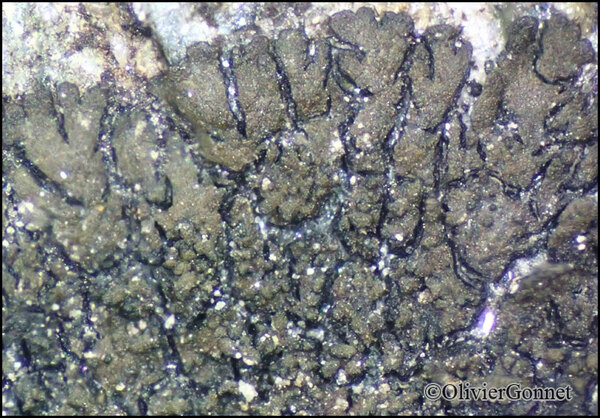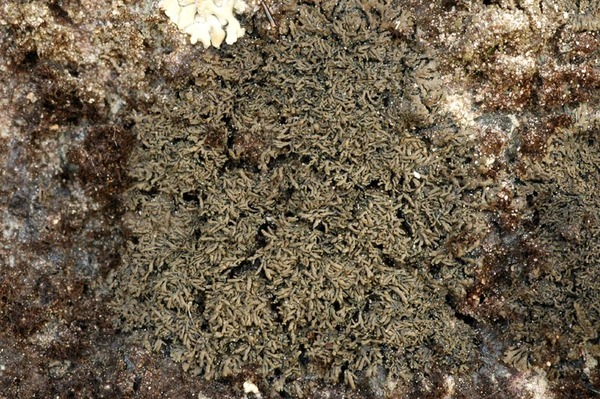Placynthium flabellosum (Tuck.) Zahlbr.
Cat. Lich. Univ., 3: 227, 1925. Basionym: Pannaria flabellosa Tuck. - Proc. Amer. Acad. Arts and Sc., 5: 401, 1862.
Synonyms: Anziella adglutinata (Anzi) Gyeln.; Lecothecium adglutinatum Anzi; Placynthium adglutinatum (Anzi) Trevis.
Distribution: N - TAA (Coste 2010, Nascimbene & al. 2022), Lomb. C - Tosc.
Description: Thallus crustose-placodioid, brown, green-brown, grey-brown or bluish grey, green-black when wet, forming 1-2(-4) cm wide rosettes, the central parts continuous to areolate, the areoles 0.5-1 mm wide and up to 1(-2) mm thick, with imbricate, flattened, isidia-like secondary lobules, the marginal lobes 1-3 x 0.3-0.5 mm, but up to 0.8 mm wide at apex, 65-150 µm thick, flat to slightly convex, usually contiguous, sparingly branched, closely attached by blue-green rhizinomorphs, flabellate, more or less smooth; prothallus absent or poorly evident. Apothecia rare, lecideine, 0.4-1(-1.5) mm across, with a brown disc and a distinctly paler proper margin. Proper exciple 90-140 µm thick, marginally with long-celled hairs; epithecium blue-green to olive-brown; hymenium colourless, 80-140 μm high; paraphyses septate, sparingly branched; hypothecium pale brown. Asci 8-spored, apically thickened, with an amyloid cap. Ascospores (2-)3-septate, hyaline, narrowly ellipsoid, (13-)15-18(-20) x 4-6(-8) μm. Pycnidial wall blue-green at least in upper part. Conidia 1-celled, hyaline, bacilliform to slightly dumbbell-shaped, 4-5 x c. 1 μm. Photobiont cyanobacterial, Scytonema-like. Spot tests: all negative. Chemistry: without lichen substances.Note: a temperate to boreal-montane, perhaps circumpolar lichen found on temporarily inundated siliceous, often mineral rich rocks along cold mountain streams and lake shores below high water level; also in drainage lines long-wetted from seeping water. For further details see Coste (2010).
Growth form: Crustose
Substrata: rocks
Photobiont: cyanobacteria, filamentous (e.g. Nostoc, Scytonema)
Reproductive strategy: mainly sexual
Most common in areas with a humid-warm climate (e.g. most of Tyrrenian Italy)
Periodically submerged (e.g. in creeks)
Commonnes-rarity: (info)
Alpine belt: very rare
Subalpine belt: rare
Oromediterranean belt: absent
Montane belt: very rare
Submediterranean belt: absent
Padanian area: absent
Humid submediterranean belt: absent
Humid mediterranean belt: absent
Dry mediterranean belt: absent

Predictive model
Herbarium samples

Courtesy Danièle et Olivier Gonnet - Source: https://www.afl-lichenologie.fr/Photos_AFL/Photos_AFL_P/Text_P_4/Placynthium_flabellosum.htm
France, 25/8/2018 - Col du Petit Mont Cenis, alt. 2200 m - Savoie

Courtesy Danièle et Olivier Gonnet - Source: https://www.afl-lichenologie.fr/Photos_AFL/Photos_AFL_P/Text_P_4/Placynthium_flabellosum.htm
France, 25/8/2018 - Col du Petit Mont Cenis, alt. 2200 m - Savoie
Growth form: Crustose
Substrata: rocks
Photobiont: cyanobacteria, filamentous (e.g. Nostoc, Scytonema)
Reproductive strategy: mainly sexual
Most common in areas with a humid-warm climate (e.g. most of Tyrrenian Italy)
Periodically submerged (e.g. in creeks)
Commonnes-rarity: (info)
Alpine belt: very rare
Subalpine belt: rare
Oromediterranean belt: absent
Montane belt: very rare
Submediterranean belt: absent
Padanian area: absent
Humid submediterranean belt: absent
Humid mediterranean belt: absent
Dry mediterranean belt: absent

Predictive model
| Herbarium samples |

Courtesy Danièle et Olivier Gonnet - Source: https://www.afl-lichenologie.fr/Photos_AFL/Photos_AFL_P/Text_P_4/Placynthium_flabellosum.htm
France, 25/8/2018 - Col du Petit Mont Cenis, alt. 2200 m - Savoie

 INDEX FUNGORUM
INDEX FUNGORUM
 GBIF
GBIF
 DOLICHENS
DOLICHENS






